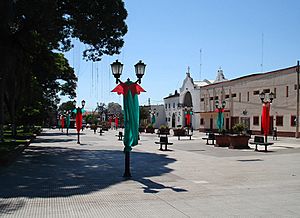San Isidro de Lules facts for kids
Quick facts for kids
San Isidro de Lules
|
|
|---|---|
 |
|
| Country | |
| Province | |
| Department | Lules |
| Population
(2010 census)
|
|
| • Total | 21,088 |
| Demonym(s) | luleño/a |
| Time zone | UTC-3 (ART) |
| CPA base |
T4128
|
| Dialing code | +54 0381 |
San Isidro de Lules, often called just Lules, is a town in northern Argentina. It is located in Tucumán Province and is the main town of the Lules department (a type of county).
Contents
What is San Isidro de Lules?
San Isidro de Lules is a lively town known for its farming. It is especially famous for growing lots of blueberries and strawberries. The town also has many factories that process food, making things like fresh juices.
How Did Lules Begin?
The Founding of Lules in 1851
Lules was started on November 20, 1851. A priest named Dr. Zoilo Domínguez founded it. He built it on the land where a Jesuit reduction used to be. A Jesuit reduction was a special community set up by Jesuit missionaries.
Why the Name San Isidro de Lules?
The town was named after Saint Isidore the Laborer, who is the patron saint of farmers. "San Isidro" means "Saint Isidore" in Spanish. The "Lules" part comes from the Lule people, who were the native people living in that area.
Early Community Development
Dr. Domínguez wanted to create a strong community. He built a school and a Roman Catholic church. After he passed away in 1865, his land was given to his five sons. However, plots around the town square were sold to the Lules Indians and other local people. This helped the community grow. In 1887, the province officially recognized Lules as a town.
What Does Lules Produce?
Farming and Food Production
Lules and the areas around it became very important for farming. They are well-known for growing blueberries and strawberries. Over time, many food processing plants opened in Lules. These factories make fresh and concentrated juices from the fruits.
Other Industries in Lules
Besides food, Lules also has other types of factories. There are paper mills, which make paper products. There are also textile mills, which produce fabrics and clothes. This mix of industries helps the town's economy.
Images for kids
See also
 In Spanish: Lules para niños
In Spanish: Lules para niños



